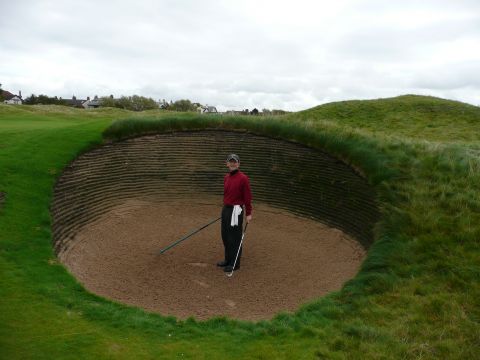Since my first trip to Scotland in 1979, I’ve been obsessed with links golf, to the extent that I’ve returned to Scotland five times since in addition to three trips to Ireland. As the addict would say, I can quit at any time…
For those only vaguely familiar with the term, “links golf” refers to a very specific variant of the game that is found only on seaside courses in the British Isles and Ireland. The British Golf Museum defines linksland this way:
A stretch of land near the coast on which the game is played, characterized by undulating terrain, often associated with dunes, infertile sandy soil, and indigenous grasses such as marram, sea lyme, and the fescues and bents which, when properly managed, produce the fine, textured, tight turf for which links are famed.
To add some color to this accurate, if somewhat clinical, definition, let me quote from “To the Linksland,” Sports Illustrated columnist Michael Bamberger’s homage to Scotland:
Do you know what I mean when I say linksland? Linksland is the old Scottish word for the earth at the edge of the sea — tumbling, duney, sandy, covered by beach grasses. When the light hits it, and the breeze sweeps over it, you get every shade of green and brown, and always, in the distance, is the water. The land was long considered worthless, except to the shepherds and their sheep and the rabbits, and to the early golfers. You see, the game comes out of the ocean, just like man himself!
There’s a primal quality to the best of these links, a knowledge that people have been playing them for hundreds of years, and that the land has been largely untouched by human hands. There’s also a remote feel as you find yourself walking amongst the dunes, often times in spots where you can’t see another golf hole or evidence of mankind’s existence. Because of the specifics of this unique terrain, the game is played differently. If you’ve watched a British Open on television, you’ll be familiar with the effects of wind and the importance of avoiding the punitive pot bunkers. First-time visitors are most surprised by the firmness of the turf and its affect on the game. There’s an obvious thrill in the ability to play low, boring shots that will run forever, but many an expletive has been uttered at the difficulty of playing a soft pitch off the incredibly tight lies.

The author tries on a Royal Lytham bunker for size. Fortunately, his ball was not actually in the bunker; otherwise, he says, he might still be there.
Those of us who have become hooked on links golf appreciate that it offers a range of options to the player, both in terms of the type of shot played and the line to the green, in sharp contrast to the more one-dimensional point-to-point golf inherent in parkland golf. In addition to the stark physical beauty of the links, the very changeability of the conditions makes it endlessly absorbing. From day-to-day, sometimes hour-to-hour, the golf course changes its look, its feel and the demands it makes of players. When possible I try to schedule multiple rounds on a given course, partially as weather insurance (you might have heard that the weather in the British Isles can be, let’s be charitable, memorable) but also because the changed conditions invariably result in a completely altered playing experience.
While we could happily return to Scotland and Ireland every year, my wife Theresa has extended family, some of whom are quite elderly, in England. Being a selfless and devoted husband, I insisted that it was long past time for her to pay them a visit. I assure all that the ability to combine this family time with a visit to the highly-regarded cluster of renowned links courses on the Northwest coast of England, known in the tourist trade as England’s Golf Coast, was the merest of considerations.
Next: Royal Liverpool (Hoylake) and Royal Lytham & St. Anne.
Scott Simpson is an avid golfer with a longstanding love of links golf. In those few hours not spent on a golf course, Scott is an investment banker focusing on middle-market mergers and acquisitions. A member of Willow Ridge Country Club north of New York City, Scott makes his home in Westchester County with his wife Theresa, a first generation County Mayo girl (as if he needed further motivation to visit Ireland). The name notwithstanding, Scott has yet to win his first U.S. Open. He says that, with a handicap of 9, “it is very difficult to make a living.”



